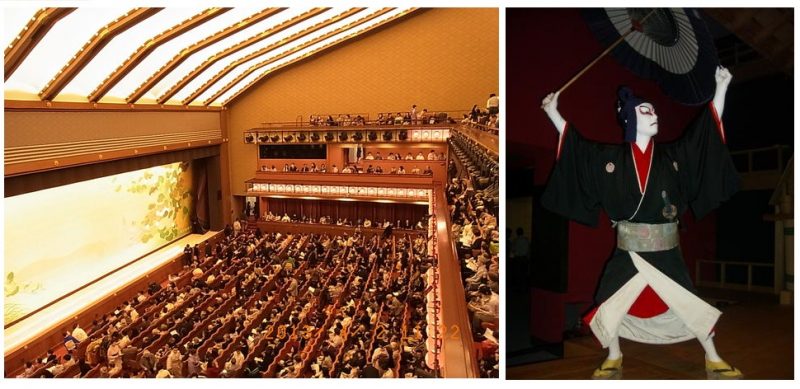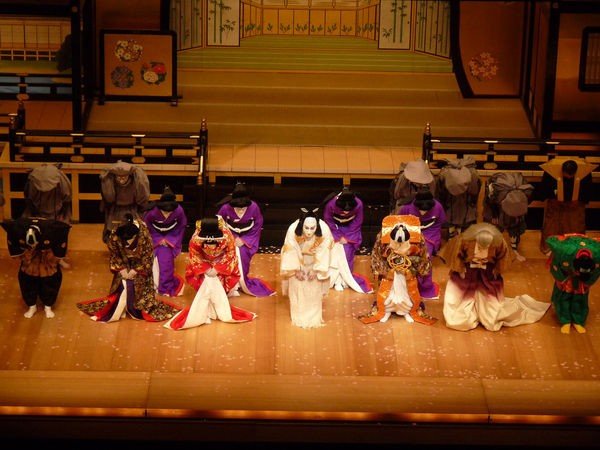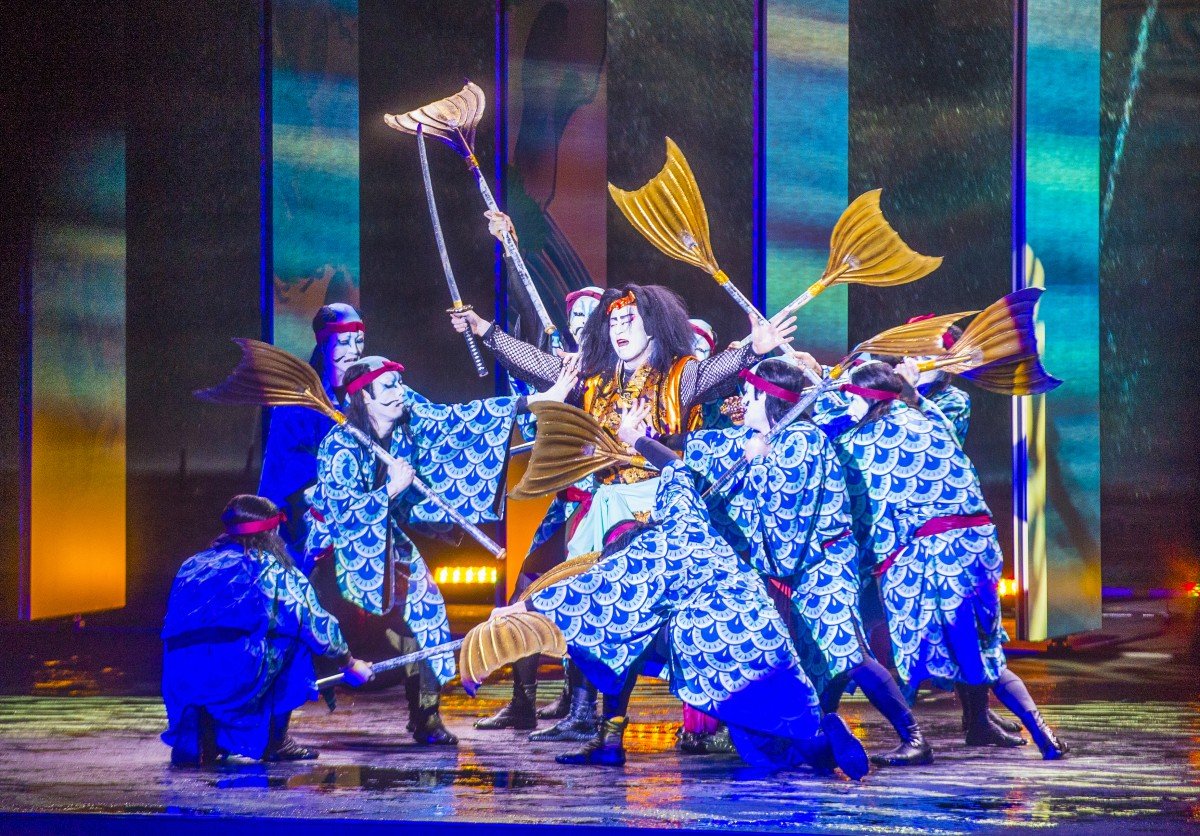Kabuki (歌舞伎) is more than a theatrical style; it is a window into the heart of traditional Japanese culture. Recognized for its striking performances, expressive makeup, and epic narratives, kabuki combines singing (ka 歌), dancing (bu 舞), and skill (ki 伎) in a spectacle that challenges time. Throughout its history, it has evolved from popular theater to a revered art form, preserving a rich and vibrant heritage.
In this article, we dive into the history, evolution, and cultural significance of kabuki, exploring why it continues to captivate audiences in Japan and beyond.
Table of Content
The Origin of Kabuki: From the Sacred to the Profane
Kabuki was born in the early 17th century in Kyoto, by the hands of Izumo no Okuni, an innovative priestess (miko). Okuni presented satirical and provocative dances that parodied the society of the time. Her performances were held on the banks of the Kamo River and attracted crowds with their combination of humor, sensuality, and social criticism.
From Rebellion to Prohibition
Initially dominated by women, the kabuki style quickly gained popularity. However, the involvement of some actresses with prostitution led the government to prohibit women on stage in 1629. To fill the gap, young boys began to take on female roles, but the impact was similar: the audience's fascination resulted in social problems, leading to yet another ban. Eventually, adult men took on the roles, and kabuki transformed into the form we know today.

Distinctive Elements of Kabuki
The kabuki is famous for its unique combination of narrative, dance, and music, but there are specific elements that make it unmistakable:
1. Makeup (Kumadori)
Kabuki makeup is not just aesthetic; it communicates the emotions and personality of the characters. Red lines represent virtue and bravery, while blue ones symbolize villainy or mystery.
2. Elaborate Costumes
The costumes of kabuki are extravagant and symbolically rich, made of luxurious fabrics and designed to emphasize the movements of the actors.
3. Movements and Dance
Every gesture in kabuki is carefully choreographed. The exaggerated movements are used to convey deep emotions, while the actors interact with the audience directly, breaking the "fourth wall."
4. Specialized Actors (Onnagata)
A striking feature of kabuki is the onnagata, men specialized in female roles. Their ability to capture the grace and delicacy of women is essential for the authenticity of the theater.

The Decline of Kabuki: From Oblivion to Rediscovery
Although kabuki experienced a golden period during the 17th and 18th centuries, it faced significant challenges over time. By the end of the 19th century, with the Meiji Restoration (1868–1912), Japan underwent an accelerated process of modernization and westernization. In this context, kabuki was seen as an outdated form of art, often associated with traditional values that the government sought to reform.
Westernization and Loss of Interest
With the introduction of new forms of entertainment, such as Western theater and cinema, the audience began to lose interest in kabuki. The emphasis on technology and progress relegated traditional arts to a secondary position, and kabuki suffered a considerable decline in popularity.
World War II and American Prohibition
During World War II, kabuki was used as a tool for nationalist propaganda, depicting stories of bravery and patriotism. After the war, the American occupation forces banned kabuki performances, claiming that it perpetuated militaristic and traditional ideas that went against the ideals of democratization. This prohibition nearly extinguished kabuki as an art form.
The Renaissance of Kabuki
Despite the adversities, kabuki found new life in the 20th century, thanks to dedicated efforts to preserve it as a cultural heritage. After the end of the American prohibition, Japan began to value its artistic traditions as part of its national identity.
International Recognition
The recognition of kabuki as Intangible Cultural Heritage of Humanity by UNESCO helped restore its prestige. It returned to the stages, attracting both curious tourists and Japanese people looking to reconnect with their cultural roots.
Government Support and Adaptation
With the support of the government and the modernization of presentations, including electronic subtitles and adaptations for foreign audiences, kabuki has reinvented itself, staying true to its roots while attracting new generations.
These moments in history highlight the decline and rebirth of kabuki, showing how it managed to survive and thrive in times of change. Today, it remains one of the greatest symbols of Japanese culture.

Kabuki in the Modern Era
After facing periods of decline, such as during the Meiji Restoration (1868–1912) and World War II, kabuki found new audiences in the 20th century. Today, it is protected as Intangible Cultural Heritage of Humanity by UNESCO and continues to captivate tourists and locals.
Kabuki in Japan Today
Currently, kabuki is performed in large theaters, such as the Kabukiza in Tokyo, where audiences can watch performances that range from historical classics to contemporary adaptations.
Kabuki in the West
The visual beauty and complexity of kabuki have also attracted international audiences. Kabuki productions have been performed worldwide, adapting to new cultural contexts while maintaining their traditional essence.

Why Watch a Kabuki Play?
Watching kabuki is not just a theatrical experience; it is an immersion in the culture and history of Japan. From heroic and tragic stories to the aesthetic beauty of the costumes and sets, each aspect of kabuki reflects centuries of tradition and innovation.
Tips for Watching Kabuki
If you are planning to watch a kabuki performance, here are some tips:
- Recommended Theaters: Kabukiza in Tokyo is the most iconic venue. In Osaka and Kyoto, there are also traditional options.
- Tickets: Many theaters offer tickets for just one act, ideal for beginners.
- Understand the History: Some performances have subtitles or audio guides in English, making it easier to understand.
Final Reflections
The kabuki is more than a theatrical performance; it is a celebration of Japanese culture and a testament to the power of art in transcending generations. Whether in Japan or on international stages, kabuki continues to captivate audiences with its unique blend of tradition and creativity.
If you have the opportunity, watch a kabuki play. It is an experience that will be etched in your memory like a journey to the heart of Japan's artistic soul.
The video below shows the artists' preparation and a modern performance in Roppongi:
